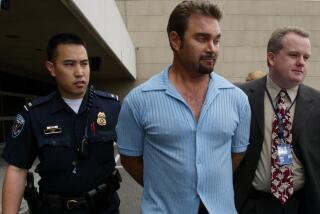Targeting a Child Molester : Sheriff Calls Operation a Success but Critics Raise the Issues of Cost and Civil Liberties
When repeat child molester Joseph Wells Noble was paroled from prison on April 11, law enforcement officials were convinced he would do it again.
Six weeks earlier, the Los Angeles County Sheriff’s Department and three South Bay police departments had joined forces to track Noble, 34, who has been in prison almost continuously since 1978 on a variety of child molestation convictions and parole violations.
The unusual operation, personally overseen by Sheriff Sherman Block, involved about 40 undercover officers who used helicopters and electronic tracking devices to keep Noble under surveillance as he visited dozens of schoolyards and parks around the county in violation of his parole, authorities said.
Their plan was not merely to send Noble back to prison until his sentence expired June 15. Instead, officials wanted to catch him in a more serious offense that would put him behind bars for years.
Over the next month and a half, the strategy consumed 2,100 hours of deputies’ time--equivalent to one deputy’s workload for a year--at a cost of about $75,000.
The plan paid off last week, when Noble was arrested on suspicion of indecent exposure after a deputy reported seeing him masturbating in his car next to the playground of an elementary school in Studio City. His record of sexual assaults makes the crime a felony with a possible five-year prison term.
“The results speak for themselves,” Block said Thursday. “It was just a short step from that particular action to perhaps a more serious action. . . . I do believe that when you start assigning dollar costs to what the potential cost may have been in human terms, it’s probably cheap.”
Noble is being held at the Los Angeles County Men’s Central Jail on a parole violation. Deputy Dist. Atty. Julie Sulman said that felony indecent exposure charges will be filed against him today.
Although child molesters are released from prison every month, Noble’s parole drew authorities’ attention, Sulman said, because of his history as a repeat offender who drove hundreds of miles a day to visit places where children congregate.
Some parolees can be kept under house arrest with an electronic anklet, but law enforcement officials decided the method was too risky because they would not know where Noble was if he slipped out.
“Let’s look at the alternative,” said Sheriff’s Sgt. Stephen Lawson. “Either we surveil him or do nothing. Until a person commits a crime, we can’t do anything. He was being monitored, but believe me, if he had gotten anywhere near a child, he would have been stopped so quickly he wouldn’t have known what hit him.”
But the strategy has its critics, who said in interviews that it was a poor use of resources and an abridgement of Noble’s civil rights.
The Noble case also highlights the problems the legal system has in dealing with repeat sex offenders. Prison offers little opportunity for rehabilitation and parole is mandatory as a convict earns time off his sentence for work and good behavior.
The February planning sessions before Noble’s release included representatives from the attorney general’s office, the Department of Corrections, district attorney’s office, Sheriff’s Department and several South Bay police departments including those of Redondo Beach, Hawthorne and El Segundo.
At the meeting, detectives were told to try to catch Noble doing something that would be severe enough to put him behind bars, but would not endanger any child. Indecent exposure, or masturbating in public or trying to entice a child into his car were among the violations they were looking for, Lawson said.
During the surveillance, an electronic tracking device was placed on Noble’s car and a helicopter was used so undercover officers could stay a couple blocks away at all times. Police at first tailed him around the clock, until they established that he did not leave his residence at night.
The plan put officers close enough “so that when he stopped at a school, we could see what he was doing,” said Sheriff’s Lt. Jim Harris, who led the surveillance. “The only way we could protect somebody was by being there.”
The time and resources used were unusual, Harris said, but “we felt . . . that he was not cured and would act again.”
Even those who questioned the sheriff’s surveillance methods agreed that Noble needed to be watched.
“Obviously, a child molester needs to be stopped and I think some surveillance may be appropriate,” said Ramona Ripston, executive director of the American Civil Liberties Union of Southern California and a critic of the Sheriff’s Department.
Nevertheless, she described the operation as excessive, criticized authorities for their cavalier attitude toward Noble’s civil liberties and questioned the use of funds.
A decade ago, the courts could sentence child molesters to hospitals rather than prison if they were found to be “mentally disordered sex offenders.” But in 1981, legislators eliminated the program after a string of clinical misjudgments persuaded them it was too risky. The most notable involved convicted child molester Theodore Frank, who tortured and killed a 2 1/2-year-old Camarillo girl just six weeks after persuading doctors at Atascadero State Hospital that he was cured.
At about the same time, the Legislature increased penalties for sex offenses.
The harsher approach ensured longer terms for sex crimes, although some in the criminal justice and mental health professions say it had an unexpected effect. Under the old system, hospitals could keep child molesters indefinitely; but prison officials now have no choice but to release them on parole.
“I am very saddened by the fact that the law (was changed) because it provided for indeterminate sentencing--a person could be held a long time” at state hospitals, said Alan Goodman, a former Atascadero State Hospital psychologist who now treats child molesters in his Beverly Hills practice. “I’m sorry the (clinical) mistakes . . . eliminated the whole law.”
Noble’s first conviction was in 1978 for committing oral copulation with a 7-year-old Redondo Beach girl and masturbating in front of three girls at a Redondo Beach elementary schoolyard.
He was sentenced to six years and four months in prison but, as a mentally disordered sex offender, was sent to a state hospital. He escaped and was captured, but not before he had molested a 6-year-old girl behind a garage near her house, Sulman said.
He pleaded guilty in September, 1978, to that offense. He was paroled in 1981, but spent most of the next three years in prison for parole violations, she said.
In 1984, he was convicted on six counts of felony child molestation and two counts of attempted kidnaping after he tried to lure two Hawthorne girls into his car.
Noble was sentenced to six years and two months in prison. He was first paroled in 1987, but was returned to prison three times in the next 2 1/2 years for violating his parole, almost always for approaching young children, Sulman said.
His parole in April to Hawthorne so outraged residents that officials were forced to move him to a board-and-care home in Long Beach. When local media began publicizing his new address, parole officials moved him again, this time to a halfway house in Inglewood, where he was living when he was arrested.
Noble’s parole agent, Nancy Anderson, said he had often spoken about wanting to change and expressed interest in receiving medication to control his impulses. She described spending a good deal of time talking to him and said she was “disappointed” at news of the arrest.
Noble “was basically afraid to talk to anybody” and that included his best friend, a born-again Christian with children.
“He was very frustrated this time because he couldn’t get a job because he was all over the news and he had this idea people were following him,” she said.
More to Read
Sign up for Essential California
The most important California stories and recommendations in your inbox every morning.
You may occasionally receive promotional content from the Los Angeles Times.










